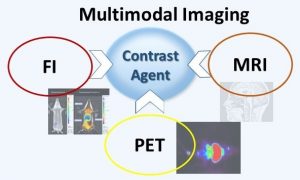
Multimodal imaging refers to the use of multiple imaging techniques to obtain complementary information about a subject. By combining information from different imaging methods, multimodal imaging can provide a more comprehensive and detailed view of the anatomy and function of the tissue being imaged.
Examples of multimodal imaging include:
- PET/CT (Positron Emission Tomography/Computed Tomography) – a combination of two imaging methods that provides information about the metabolic activity of the tissue and its anatomy.
- PET/MRI (Positron Emission Tomography/Magnetic Resonance Imaging) – a combination of PET and MRI, which provides information about the metabolic activity and the anatomy of the tissue.
- Multimodal MRI (Magnetic Resonance Imaging) – a combination of different MRI techniques, such as T1-weighted, T2-weighted, and diffusion-weighted imaging, to provide a more complete picture of the anatomy and function of the tissue being imaged.
Multimodal imaging is used in a variety of medical applications, including cancer diagnosis and treatment, neurology, and cardiology, among others. It is also commonly used in research to study the anatomy and function of various organs and tissues.
The three main types of diagnostic imaging are:
- Radiology: Radiology involves the use of ionizing radiation, such as X-rays, to produce images of the inside of the body. It is commonly used to visualize bones, soft tissue, and foreign objects in the body.
- Ultrasound: Ultrasound uses high-frequency sound waves to produce images of the inside of the body. It is commonly used to visualize internal organs, blood flow, and developing fetuses.
- Magnetic Resonance Imaging (MRI): MRI uses a strong magnetic field and radio waves to produce detailed images of the inside of the body. It is commonly used to visualize soft tissues, such as the brain, muscles, and organs, and to evaluate blood flow and metabolic activity.
The market size of imaging diagnostics is difficult to quantify as it is constantly changing and depends on various factors such as global economic conditions, advances in technology, and increasing demand for medical imaging services.
However, as of 2021, the global imaging diagnostics market was estimated to be worth around US $40 billion, with a projected annual growth rate of around 4-5%. The market is expected to continue growing as the demand for medical imaging services increases and new technologies are developed.
It is worth noting that the COVID-19 pandemic had a significant impact on the imaging diagnostics market, causing disruptions in supply chains and a decrease in demand for imaging services due to lockdowns and decreased patient visits. However, the market is expected to recover and continue its growth trajectory post-pandemic.
Here are some of the recent trends in the multimodal imaging market:
- Advancements in Technology: The development of new imaging techniques and the integration of multiple imaging modalities into single devices is driving growth in the multimodal imaging market.
- Increased Demand for Non-Invasive Diagnostic Tools: The demand for non-invasive diagnostic tools is increasing as patients seek alternatives to traditional invasive diagnostic procedures. Multimodal imaging provides a non-invasive way to obtain detailed images of the inside of the body.
- Growing Prevalence of Chronic Diseases: The growing prevalence of chronic diseases, such as cancer, cardiovascular diseases, and neurological disorders, is driving demand for more advanced diagnostic imaging tools.
- Rising Adoption of Artificial Intelligence and Machine Learning: The integration of artificial intelligence (AI) and machine learning into imaging diagnostics is enabling more accurate diagnoses and improving patient outcomes.
- Expansion of Telemedicine Services: The growth of telemedicine services is providing new opportunities for remote imaging and interpretation, making it easier for patients to access imaging services.
- Increased Demand for Portable Devices: The demand for portable multimodal imaging devices is growing, as they provide greater flexibility and convenience for patients and healthcare providers.
- Growth in Emerging Markets: The demand for multimodal imaging services is increasing in emerging markets,
Here are some of the major companies in the multimodal imaging market:
- General Electric (GE) Healthcare
- Siemens Healthineers
- Philips Healthcare
- Toshiba Medical Systems Corporation
- Hitachi Medical Corporation
- Shimadzu Corporation
- Samsung Medison Co., Ltd.
- Canon Medical Systems Corporation
- Esaote S.p.A
- Fujifilm Holdings Corporation
These companies are involved in the development, manufacturing, and marketing of multimodal imaging equipment and services. They offer a range of products, including computed tomography (CT) scanners, magnetic resonance imaging (MRI) systems, and positron emission tomography (PET) scanners. Some of these companies also offer telemedicine solutions and cloud-based imaging services, as well as AI and machine learning-powered image analysis tools.
Contact:
David Correa
5933 NE Win Sivers Drive
205, Portland, OR 97220
United States
USA/Canada (Toll Free): +1-800-792-5285, +1-503-894-6022
UK: +44-845-528-1300
Hong Kong: +852-301-84916
India (Pune): +91-20-66346060
Fax: +1(855)550-5975
help@alliedmarketresearch.com
About Us
Allied Market Research (AMR) is a full-service market research and business-consulting wing of Allied Analytics LLP based in Portland, Oregon. Allied Market Research provides global enterprises as well as medium and small businesses with unmatched quality of “Market Research Reports” and “Business Intelligence Solutions.” AMR has a targeted view to provide business insights and consulting to assist its clients to make strategic business decisions and achieve sustainable growth in their respective market domain.

